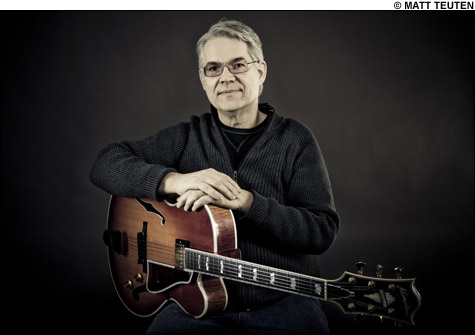
IT IS WRITTEN “A lot of free music is too free.” |
WFNX Jazz Brunch Top Five
1. The Bad Plus, For All I Care [Heads Up]
2. Marco Benevento, Me Not Me [Blue Potato Family]
3. Joshua Redman, Compass [Nonesuch]
4. Derek Trucks, Already Free [Victor]
5. The Blue Note 7, Mosaic [Blue Note] |
By the time guitarist Garrison Fewell made his first record as a leader, in the early '90s, he was nearly 40 years old, and the sound he displayed on his debut, A Blue Deeper Than Blue, was ripe. Here was nuanced coloristic shading, subtle swing, a sure melodic sense, rich harmonic palette, detailed fingerwork, and what critic Ed Hazell called in his liner notes a distinctive "cashmere sound." It was post-bop guitar out of the Jim Hall school, refined and lyrical.So fans of A Blue Deeper Than Blue — and Fewell's two other '90s releases on Cambridge's Accurate Records — might be surprised to hear his new Variable Density Sound Orchestra (Creative Nation Music). Whereas the music on those discs cycled faithfully through harmonically explicit chord progressions over clearly stated meters, the 10 pieces on the new one play with more-open forms. They float through ambiguous tonal centers, move in and out of tempo, break for solos that may or may not adhere to a given theme. The classic post-bop format of those early discs — guitar, piano, bass, drums — has been supplanted by arrangements for sextet and septet and a small orchestra of sounds: Fewell and Creative Nation Music honcho Eric Hofbauer on guitars, New York avant-gardist Roy Campbell Jr. on trumpet, flügelhorn, and flutes, esteemed Italian reedman Achille Succi on bass clarinet and alto saxophone, veteran Boston bassist John Voigt, Boston drummer Miki Matsuki, and Fewell's son Alex on percussion. In fact, everyone plays percussion, Fewell and Hofbauer adding to the mix with "prepared" guitar passages.
What hasn't changed is Fewell's sense of melodic lyricism or the compositional intent of each piece, no matter how free. Collective free-improv alternates with bass vamps, unison themes, previously agreed-upon strategies. As on 2006's superb Good Night Songs (Boxholder) with Fewell and saxophonists John Tchicai and Charlie Kohlhase, the tension between form and freedom and the "variable density" of timbre and texture replace standard structures and create their own sense of narrative expectancy, suspense, and resolution. Still, how did he get from there to here — the mainstream jazz guitarist to the free experimenter?
"It was an alien abduction," Fewell (who brings his Orchestra — plus trombonist Steve Swell and second bassist Dmitry Ishenko — to the YMCA Theater in Central Square this Friday) tells me straight-faced when we get together in the lobby of the Charles Hotel, downstairs from the Regattabar. "It's similar to what happened to Sun Ra. When I came back, I was changed."
In truth, the change had been coming on for years. "I was listening to music that I wasn't playing" — people like Sun Ra, David Murray, the South Africans Dudu Pukwana and Johnny Dyanni, the Afro-Dutch Tchicai. Fewell wanted to integrate some of what he'd been listening to into his own music, but he wasn't sure how. By chance, he ran into Hazell, and the two got to talking. "Ed said he thought there were two kinds of free jazz: melodic and anti-melodic." He saw Fewell as a potential melodic free player. "You know, when a friend challenges you and says, 'Yeah, you should do that!' "